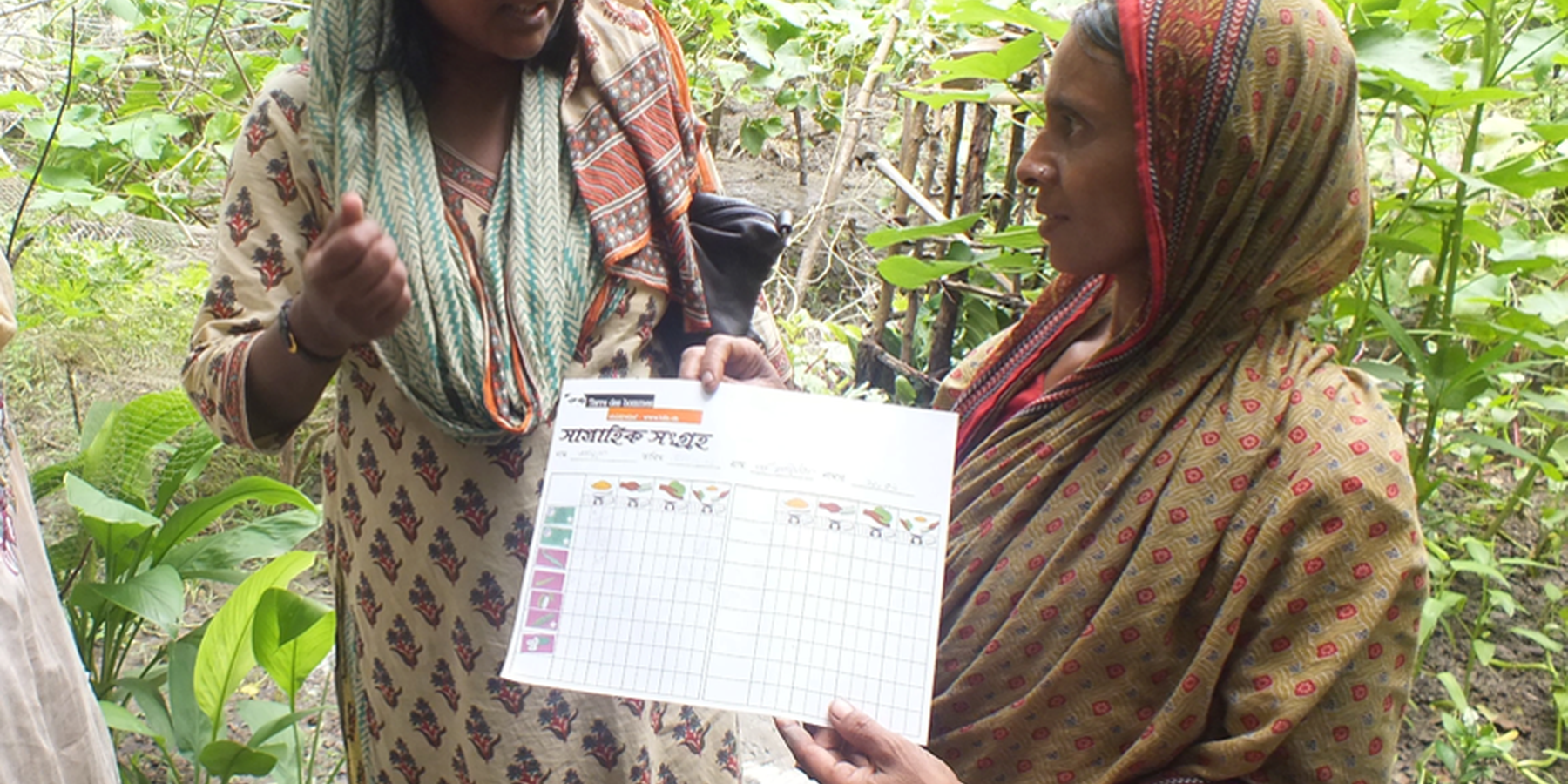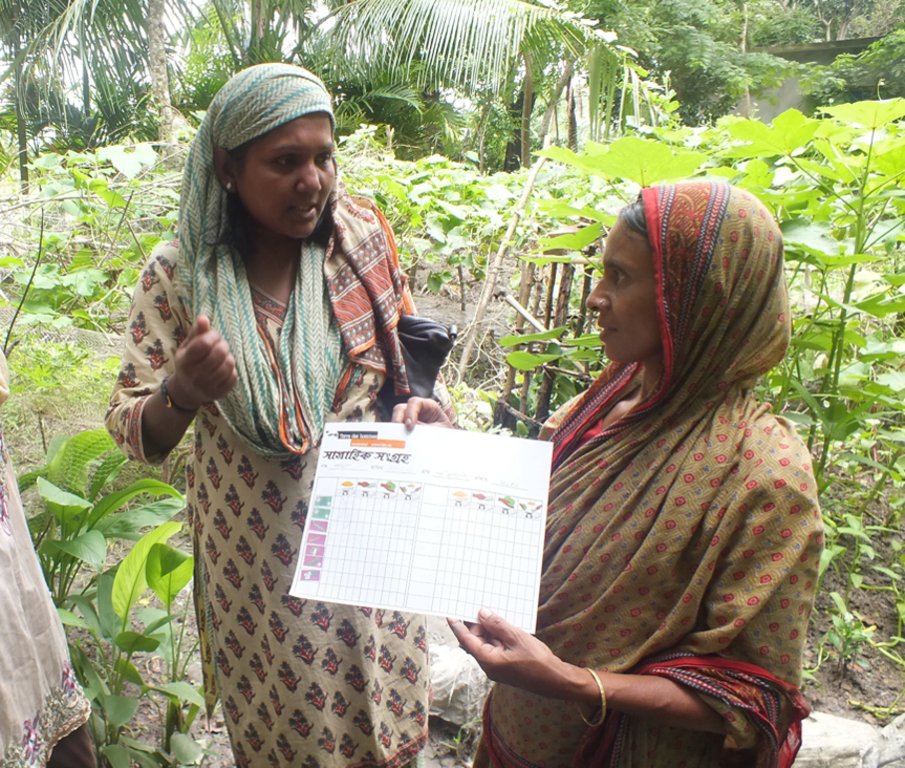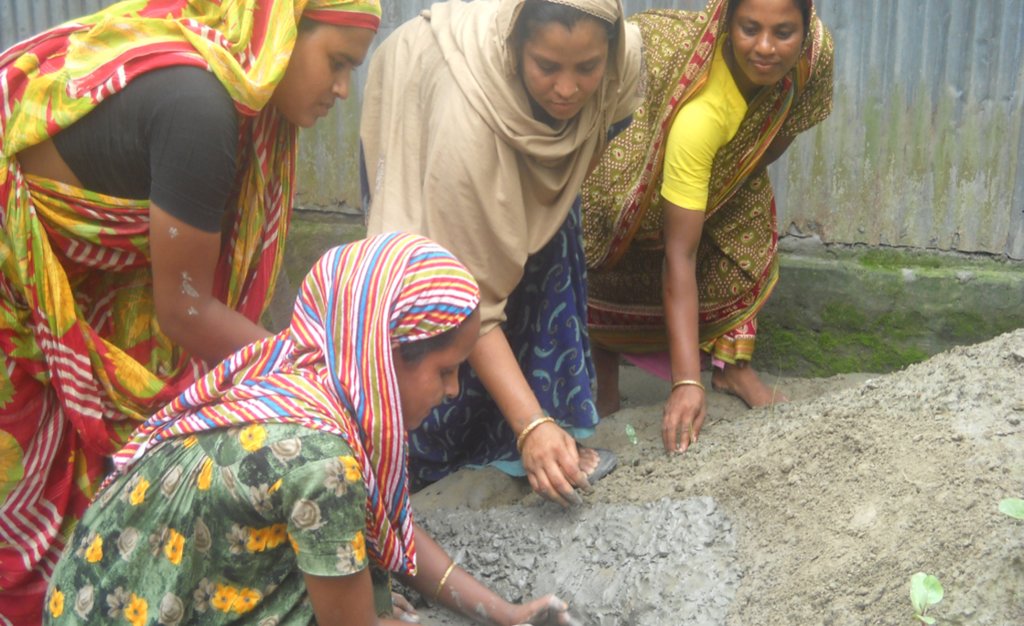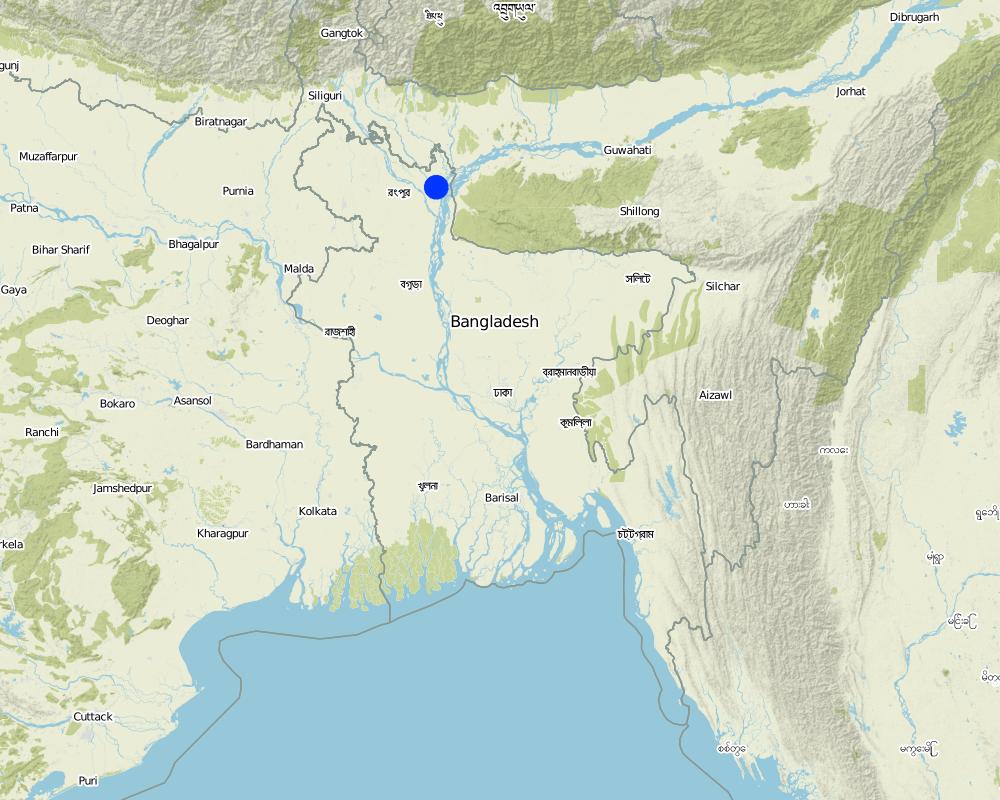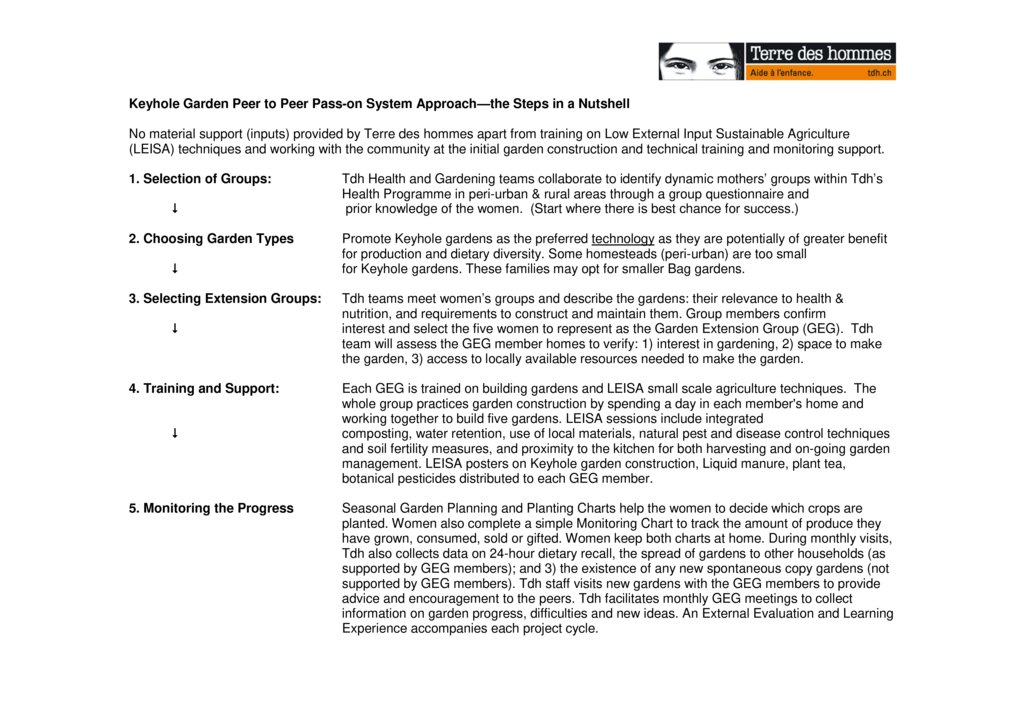Peer to Peer Pass-on Approach with Women [บังกลาเทศ]
- ผู้สร้างสรรค์:
- การอัพเดท:
- ผู้รวบรวม: John Brogan
- ผู้เรียบเรียง: Shahid Kamal
- ผู้ตรวจสอบ: Alexandra Gavilano, Boris Orlowsky
approaches_784 - บังกลาเทศ
ดูส่วนย่อย
ขยายทั้งหมด ย่อทั้งหมด1. ข้อมูลทั่วไป
1.2 รายละเอียดที่ติดต่อได้ของผู้รวบรวมและองค์กรที่เกี่ยวข้องในการประเมินและการจัดเตรียมทำเอกสารของแนวทาง
วิทยากรหลัก
ผู้เชี่ยวชาญ SLM:
Brogan John
john.brogan@tdh.ch
Terre des hommes
15 Avenue Montchoisi 1006 Lausanne
สวิตเซอร์แลนด์
WASH/DRR Advisor:
ผู้เชี่ยวชาญ SLM:
Taylor Sheila
Sheila.Taylor@sendacow.org
Send a Cow UK
ชื่อของโครงการซึ่งอำนวยความสะดวกในการทำเอกสารหรือการประเมินแนวทาง (ถ้าเกี่ยวข้อง)
Book project: where people and their land are safer - A Compendium of Good Practices in Disaster Risk Reduction (DRR) (where people and their land are safer)ชื่อของโครงการซึ่งอำนวยความสะดวกในการทำเอกสารหรือการประเมินแนวทาง (ถ้าเกี่ยวข้อง)
Terre des Hommes (Terre des Hommes) - สวิตเซอร์แลนด์1.3 เงื่อนไขที่เกี่ยวข้องกับการใช้ข้อมูลที่ได้บันทึกไว้ผ่านทาง WOCAT
วันที่เก็บรวบรวมข้อมูล (ภาคสนาม):
14/08/2013
ผู้รวบรวมและวิทยากรหลักยอมรับเงื่อนไขเกี่ยวกับการใช้ข้อมูลที่ถูกบันทึกผ่านทาง WOCAT:
ใช่
1.4 การอ้างอิงถึงแบบสอบถามเรื่องเทคโนโลยี SLM
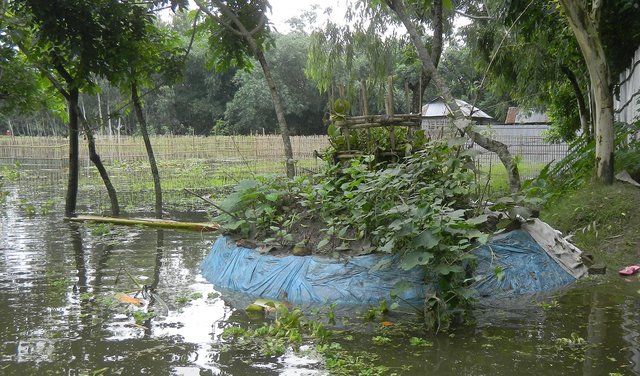
Keyhole Garden [บังกลาเทศ]
The Keyhole Garden model of homestead vegetable cultivation enhances the resilience of families living in areas with climate-related hazards, such as flooding and drought. Keyhole gardens have been shown to increase vegetable production in all seasons, thereby improving household food autonomy and dietary diversity.
- ผู้รวบรวม: John Brogan
2. คำอธิบายของแนวทาง SLM
2.1 การอธิบายแบบสั้น ๆ ของแนวทาง
Terre des hommes and Greendots introduced the Peer to Peer pass-on system to enable women's groups in Bangladesh to spread the Keyhole Garden technique within their communities with the aim of enabling year-round homestead vegetable production despite the risk of flooding and tidal surge.
2.2 การอธิบายอย่างละเอียดของแนวทาง
การอธิบายอย่างละเอียดของแนวทาง:
Keyhole Gardens, a type of small, productive homestead vegetable garden based on Low External Input Sustainable Agriculture (LEISA) techniques, have been used in various African countries for over 15 years and shown to increase the availability of food and dietary diversity (FAO). They were developed by gardeners and small-scale farmers (with the support of Send a Cow UK) to suit different situations, such as the cold, dry winters of Lesotho, the small backyards of Rwanda, and the humid heat of central Uganda. To improve year-round homestead nutritional self-sufficiency for vulnerable families in South Asia (where rates of acute malnutrition in young children regularly cross emergency thresholds), Keyhole gardens were adapted by Terre des hommes (Tdh) and Greendots to the conditions of river basin and coastal areas of Bangladesh (and eventually to India's Sundarbuns) . As a component to Tdh's maternal neonatal and child health (MNCH) programme, the technology is intended to support year-round homestead gardening despite weather extremes (flooding, tidal surge, cyclones).
To promote spontaneous replication of the Keyhole gardening in the local communities, the programme initiated a Peer to Peer Pass-on system within 40 mothers' groups (having a total membership of nearly 800 women). Each mothers' group selected five representatives (200 women) to form a Garden Extension Group (GEG) and participate in the first round of training with the understanding that they would share knowledge with other women in the MNCH programme and the surrounding community. The project team trained each GEG on building gardens and LEISA small scale agriculture techniques (including integrated composting, water retention, use of local materials, natural pest and disease control techniques and soil fertility measures, proximity to the kitchen for optimal management and harvesting). GEG group members practiced garden construction by working together to build gardens at the homes of all five members. All 200 initial gardens were monitored by Tdh extension workers on a weekly basis. Tdh verified output, use and the capacity of gardens to withstand monsoon conditions, and the extent of the of the Peer to Peer Pass-on experience.
See the Chart in Section 3.3 for more information.
2.3 รูปภาพของแนวทาง
2.4 วีดีโอของแนวทาง
ความคิดเห็น อธิบายสั้นๆ:
https://www.youtube.com/watch?v=WmDgGa0XIO8
BBC Media Action Bangladesh produced a segment on its "Amrai Pari" programme for the Bangladeshi public (in Bangla language) describing women's use and promotion of the Keyhole Garden technique in coastal communities on the Bay of Bengal.
วันที่:
09/11/2014
สถานที่:
Barguna District, Barisal Division, Bangladesh
ชื่อของผู้ถ่ายวีดีโอ:
BBC Media Action
2.5 ประเทศ ภูมิภาค หรือสถานที่ตั้งที่ได้นำแนวทางไปใช้
ประเทศ:
บังกลาเทศ
ภูมิภาค/รัฐ/จังหวัด: :
Kurigram District / Rajshahi Division and Barguna District / Barisal Division
ข้อมูลเฉพาะเพิ่มเติมของสถานที่ตั้ง:
Kurigram municipality (Kurigram District), Patharghata Union (Barguna District)
Map
×2.6 วันที่เริ่มต้นและสิ้นสุดของแนวทาง
ระบุปีที่เริ่ม:
2012
2.7 ประเภทของแนวทาง
- ใช้โครงงานหรือแผนงานเป็นฐาน
2.8 เป้าหมายหรือวัตถุประสงค์หลักของแนวทาง
The main aims of the approach are to involve women by building their capacity and peer network to replicate the Keyhole gardening approach within their communities.
The main objective of the approach is that that families, led by women 1) garden year-round with LEISA techniques, 2) increase the quantity and diversity of their homestead vegetable production and 3) verify that the DRR garden design reduces the consequences of flooding and tidal surge.
2.9 เงื่อนไขที่เอื้ออำนวยหรือเป็นอุปสรรคต่อการนำเทคโนโลยีภายใต้แนวทางนี้ไปปฏิบัติใช้
บรรทัดฐานและค่านิยมทางสังคม วัฒนธรรม ศาสนา
- เอื้ออำนวย
Acceptance of women's groups, existing mothers' groups within Health programme
ความรู้เกี่ยวกับ SLM การเข้าถึงการสนับสนุนด้านเทคนิค
- เอื้ออำนวย
The Approach calls for capacity building on LEISA techniques (knowledge on SLM) via the Peer to Peer Pass-on system to spread the DRR-designed gardens.
3. การมีส่วนร่วมและบทบาทของผู้มีส่วนได้ส่วนเสียที่เกี่ยวข้อง
3.1 ผู้มีส่วนได้ส่วนเสียที่เกี่ยวข้องในแนวทางนี้และบทบาท
- ผู้ใช้ที่ดินระดับท้องถิ่นหรือชุมชนระดับท้องถิ่น
Homestead land users (women)
Building the gardens: learning and eventually training their peers
- องค์กรที่ขึ้นอยู่กับชุมชน
Mothers' groups
Garden extension groups to share the Keyhole Garden techniques within the scope of their maternal neonatal & child health & activities
- ผู้เชี่ยวชาญ SLM หรือที่ปรึกษาการเกษตร
Greendots (www.greendots.ch)
Technical support with design of the approach: Daniel Varadi and Sheila Taylor.
- องค์การระหว่างประเทศ
Terre des hommes (international NGO)
Project implementing Agency, direct connection with women's groups within its MNCH Programme via Dr. Sultana Al-Amin (Gardening Specialist).
ถ้ามีผู้มีส่วนได้ส่วนเสียหลายคนที่เกี่ยวข้องให้ระบุหน่วยงานตัวแทน:
Terre des hommes
3.2 การเกี่ยวข้องของผู้ใช้ที่ดินระดับท้องถิ่นหรือชุมชนระดับท้องถิ่นในช่วงต่างๆของแนวทาง
| ความเกี่ยวข้องของผู้ใช้ที่ดินระดับท้องถิ่นหรือชุมชนระดับท้องถิ่น | ระบุผู้ที่มีส่วนเกี่ยวข้องและอธิบายกิจกรรม | |
|---|---|---|
| การริเริ่มหรือการจูงใจ | ไม่ลงมือ | Terre des hommes and Greendots working through existing women's MNCH nutrition groups, requested groups to nominate five women to receive the training. |
| การวางแผน | ไม่ลงมือ | As with all village-level activities, Terre des hommes works with a community volunteer in each village to plan the training and group interventions. |
| การดำเนินการ | ระดมกำลังด้วยตนเอง | Once the women were trained, they were free to honor their commitments to train other women. |
| การติดตามตรวจสอบหรือการประเมินผล | ปฏิสัมพันธ์ | Self planning and monitoring tools were introduced to the women--who decided whether to use them. Tdh provided monthly support visits to help interested women to update the planning and monitoring documents as needed, and to collect data. |
3.3 แผนผังแสดงขั้นตอนการทำงาน (ถ้ามี)
3.4 การตัดสินใจเลือกใช้เทคโนโลยี SLM
ระบุผู้ที่ทำการตัดสินใจเลือกเทคโนโลยีมากกว่าหนึ่งวิธีไปปฏิบัติใช้:
- ผู้ใช้ที่ดินเป็นผู้ตัดสินใจหลัก โดยการสนับสนุนจากผู้เชี่ยวชาญ SLM
การอธิบาย:
The Keyhole garden technique was introduced by Tdh, and went through informal adaptation and development with farmers and women's groups so that the final design was chosen by the communities and reflected the construction preferences and innovations of the users.
ระบุว่าการตัดสินใจตั้งอยู่บนพื้นฐานของ:
- ประสบการณ์และความคิดเห็นส่วนตัว (ไม่ได้ลงบันทึกไว้)
4. การสนับสนุนด้านเทคนิค การสร้างขีดความสามารถ และการจัดการด้านความรู้
4.1 การสร้างขีดความสามารถ / การอบรม
ได้มีการจัดอบรมให้แก่ผู้ใช้ที่ดินหรือผู้มีส่วนได้ส่วนเสียคนอื่น ๆ หรือไม่:
ใช่
ให้ระบุว่าใครเป็นผู้ได้รับการอบรม:
- ผู้ใช้ที่ดิน
- เจ้าหน้าที่ภาคสนาม / ที่ปรึกษา
รูปแบบการอบรม:
- กำลังดำเนินการ
- เกษตรกรกับเกษตรกร
4.2 การบริการให้คำแนะนำ
ผู้ใช้ที่ดินมีการเข้าถึงการรับบริการให้คำปรึกษาหรือไม่:
ใช่
ระบุว่ามีบริการให้คำปรึกษาหรือไม่:
- ไปเยี่ยมชมสถานที่
4.3 การเสริมความแข็งแกร่งให้กับสถาบัน (การพัฒนาองค์กร)
สถาบันได้รับการจัดตั้งขึ้นมาหรือเสริมความแข็งแกร่งโดยแนวทางนี้หรือไม่:
- ไม่
4.4 การติดตามตรวจสอบและประเมินผล
การติดตามตรวจสอบและประเมินผลเป็นส่วนหนึ่งของแนวทางหรือไม่:
ใช่
4.5 การวิจัย
การวิจัยเป็นส่วนหนึ่งของแนวทางหรือไม่:
ไม่ใช่
5. การสนับสนุนด้านการเงินและวัสดุอุปกรณ์
5.1 ระบุงบประมาณประจำปีสำหรับแนวทาง SLM นี้
ถ้าหากว่างบประมาณประจำปีไม่เป็นที่ทราบแน่นอน ให้ระบุช่วงลงไป:
- 2,000-10,000
5.2 การสนับสนุนด้านการเงิน / วัสดุอุปกรณ์ให้แก่ผู้ใช้ที่ดิน
ผู้ใช้ที่ดินได้รับการสนับสนุนด้านการเงิน / วัสดุอุปกรณ์ไปปฏิบัติใช้เทคโนโลยีหรือไม่:
ไม่ใช่
5.3 เงินสนับสนุนสำหรับปัจจัยนำเข้า (รวมถึงแรงงาน)
- ไม่มี
ถ้าแรงงานโดยผู้ใช้ที่ดินเป็นปัจจัยนำเข้าที่มีอยู่มากมาย ระบุด้วยว่าเนื่องจาก:
- สมัครใจ
5.4 เครดิต
มีการจัดหาเครดิตมาให้ภายใต้แนวทาง SLM หรือไม่:
ไม่ใช่
5.5 แรงจูงใจหรือเครื่องมืออื่น ๆ
แรงจูงใจหรือเครื่องมืออื่น ๆ ได้ถูกนำไปใช้ส่งเสริมการใช้เทคโนโลยี SLM หรือไม่:
ไม่ใช่
6. การวิเคราะห์ผลกระทบและการสรุป
6.1 ผลกระทบของแนวทาง
ทำให้ผู้ใช้ที่ดินระดับท้องถิ่นมีอำนาจขึ้น ปรับปรุงการเข้าร่วมของผู้มีส่วนได้ส่วนเสียให้ดีขึ้นหรือไม่:
- ไม่ใช่
- ใช่ เล็กน้อย
- ใช่ ปานกลาง
- ใช่ อย่างมาก
ช่วยให้ผู้ใช้ที่ดินนำเอาเทคโนโลยี SLMไปใช้และบำรุงรักษาสภาพไว้ได้หรือไม่:
- ไม่ใช่
- ใช่ เล็กน้อย
- ใช่ ปานกลาง
- ใช่ อย่างมาก
ปรับปรุงความร่วมมือกันและการดำเนิน งานของ SLM ได้อย่างมีประสิทธิผลหรือไม่:
- ไม่ใช่
- ใช่ เล็กน้อย
- ใช่ ปานกลาง
- ใช่ อย่างมาก
ปรับปรุงความรู้และความสามารถของผู้ใช้ที่ดินในการดำเนินการ SLM หรือไม่:
- ไม่ใช่
- ใช่ เล็กน้อย
- ใช่ ปานกลาง
- ใช่ อย่างมาก
ทำให้กลุ่มด้อยโอกาสมีอำนาจทางสังคมและเศรษฐกิจหรือไม่:
- ไม่ใช่
- ใช่ เล็กน้อย
- ใช่ ปานกลาง
- ใช่ อย่างมาก
ปรับปรุงความทัดเทียมกันด้านเพศและให้อำนาจแก่ผู้หญิงและเด็กผู้หญิงหรือไม่:
- ไม่ใช่
- ใช่ เล็กน้อย
- ใช่ ปานกลาง
- ใช่ อย่างมาก
นำไปสู่ความมั่นคงด้านอาหารหรือปรับปรุงโภชนาการให้ดีขึ้น:
- ไม่ใช่
- ใช่ เล็กน้อย
- ใช่ ปานกลาง
- ใช่ อย่างมาก
ปรับปรุงความสามารถของผู้ใช้ที่ดินในการปรับตัวให้เข้ากับการเปลี่ยนแปลงของสภาพภูมิอากาศหรือสภาพที่รุนแรงและภัยพิบัติหรือไม่:
- ไม่ใช่
- ใช่ เล็กน้อย
- ใช่ ปานกลาง
- ใช่ อย่างมาก
6.2 แรงจูงใจหลักของผู้ใช้ที่ดินเพื่อที่จะนำ SLM ไปปฏิบัติใช้
- การผลิตที่เพิ่มขึ้น
Families reported growing in places and a season where it is not usually possible and have more access to leafy vegetables even in a severe flood year. "On plain land the roots zone rots at this time of year, so we can’t cultivate."
- ความเสี่ยงของภัยพิบัติลดลง
Floods prevented families from growing anything last year. The plinth heights were adequate so that this year's floods did not hamper vegetables. The main benefit has been plants not rotted and damaged as in previous flood years.
- จิตสำนึกด้านสิ่งแวดล้อม
No chemical fertilizers are needed and the Keyhole Garden vegetables taste better than vegetables from the markets.
6.3 ความยั่งยืนของกิจกรรมของแนวทาง
ผู้ใช้ที่ดินสามารถทำให้สิ่งต่างๆ ที่ได้ปฏิบัติใช้โดยแนวทางนี้ยั่งยืนได้หรือไม่ (โดยไม่มีการสนับสนุนจากภายนอก):
- ใช่
ถ้าตอบว่าใช่ ให้อธิบายว่าอย่างไร :
The gardens have no physical inputs from Tdh, and require low external inputs required from families thanks to use of local natural resources. The ‘Farmer to farmer’ or peer to peer pass on learning system is the preferred method for dissemination, and favors group learning and working on the garden planning, monitoring, construction and maintenance together. Once initiated during a project cycle, does not require resources to continue. The diversity of vegetables decreases risk of total crop losses, increases opportunities for nutritional optimization and decreased risk of recurrent malnutrition. Finally, the use of local seed banks, homestead seed production and seed sharing promotes crop genetic diversity.
One woman described how a neighbour has asked her to help build a Keyhole Garden; over the 4 to 5 months she has had it, two to three neighbours have expressed serious interest in the garden. Garden management requires weeding and other work; and because Tdh gives low support she is doing it for herself.
6.4 จุดแข็งและข้อได้เปรียบของแนวทาง
| จุดแข็ง / ข้อได้เปรียบของแนวทางในทัศนคติของผู้ใช้ที่ดิน |
|---|
| Those who pass on their vegetables and skills are sometimes invited to share positive testimonials and participate in official events to further share the techniques |
| Skills and knowledge can be passed on not only to other women/farmers but also to local school students—who can pass on new skills to their parents. |
| One Send a Cow UK beneficiary described her happiness about being part of the “chain of giving” in her community. |
| จุดแข็ง / ข้อได้เปรียบของแนวทางในทัศนคติของผู้รวบรวมหรือวิทยากรหลัก |
|---|
| The underpinning ethos of this nutrition/gardening project is that it is developed and implemented using participatory processes. |
| Beyond dissemination of technology, peer farmers have a bigger emphasis on support and understanding principles of the different practices since the focus is on two-way communication. |
| Local champions of the pass-on approach have returned to support implementing partner staff through training and extension work in other communities. |
| Passing on can also help restore dignity and pride in smallholder farming communities--and strengthen the social fabric. |
6.5 จุดอ่อน / ข้อเสียเปรียบของแนวทางและวิธีในการแก้ไข
| จุดอ่อน / ข้อเสียเปรียบในทัศนคติของผู้ใช้ที่ดิน | สามารถแก้ไขปัญหาได้อย่างไร |
|---|---|
| Discontent could arise if the pace of outreach from peer pass-on system is slow while the interest is high (to receive training). For example, women could start to prepare materials to build gardens and get frustrated if the | Once the techniques to be shared have demonstrated success, the pass-on group should carefully plan and communicate the initiative for sharing the techniques to the wider community. |
| จุดอ่อน / ข้อเสียเปรียบในทัศนคติของผู้รวบรวมหรือวิทยากรหลัก | สามารถแก้ไขปัญหาได้อย่างไร |
|---|---|
| Replication and synergies with other projects and organizations must be continuously explored. | Sharing experiences with local and regional Agricultural Extension authorities, potential partner organizations and other institutes active in SLM techniques. |
7. การอ้างอิงและการเชื่อมต่อ
7.1 วิธีการหรือแหล่งข้อมูล
- การเก็บรวบรวมมาจากรายงานและเอกสารที่มีอยู่
Sheila Taylor and Daniel Varadi (Greendots.ch)
Rob Van Hout (External evaluator)
Dr. Sultana Al-Amin (Terre des hommes)
7.2 การอ้างอิงถึงสิ่งตีพิมพ์
ชื่อเรื่อง ผู้เขียน ปี ISBN:
The impact of Peer Farmer training in Western Kenya: Pricing peer training services for a sustainable Peer Farmer organisation, Martin Viera, Send a Cow UK, 2013
ช่องทางในการสืบค้น และราคา:
http://www.sendacow.org.uk/assets/files/Kenya%20Peer%20Farmer%20Review%20Summary%20Report.pdf
ชื่อเรื่อง ผู้เขียน ปี ISBN:
The Volunteer Farmer-Trainer Extension Approach: A User Guide. Technical Manual. Kirui J, et al., World Agroforestry Centre, 2016.
ช่องทางในการสืบค้น และราคา:
http://www.worldagroforestry.org/downloads/Publications/PDFS/TM16068.pdf
7.3 เชื่อมโยงกับข้อมูลที่มีอยู่บนออนไลน์
ชื่อเรื่องหรือคำอธิบาย:
Send a Cow UK - Peer to Peer Pass on Approach
URL:
https://www.sendacow.org/the-pass-it-on-approach
ลิงก์และโมดูล
ขยายทั้งหมด ย่อทั้งหมดลิงก์

Keyhole Garden [บังกลาเทศ]
The Keyhole Garden model of homestead vegetable cultivation enhances the resilience of families living in areas with climate-related hazards, such as flooding and drought. Keyhole gardens have been shown to increase vegetable production in all seasons, thereby improving household food autonomy and dietary diversity.
- ผู้รวบรวม: John Brogan
โมดูล
ไม่มีโมดูล


